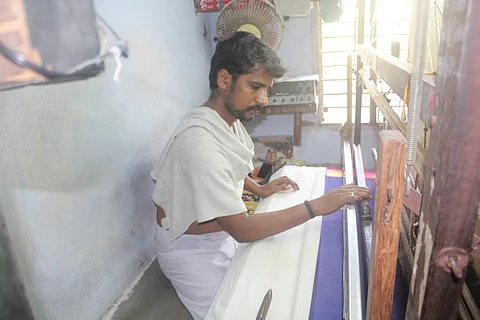No hands to weave the precious Kanchipuram saree as youngsters seek greener pastures
Thaniyarasa, 54, a master weaver, stands watch over the workers, as they work on the looms at Krishnan Street, in Pillayar Palayam in Kanchipuram. He has been in the weaving business for the past 15 years and is also the president of the Anna Weaver’s Association.
But when he dies, his skills and knowledge will die with him. It’s a bitter-sweet feeling for him, knowing that the profession itself might die with his generation, since he is happy that his children have found better work elsewhere and does not want them to get into the weaving trade.
“Two of my children are working in Meenakshi College, one as a lecturer and the other as an auditor,” he announces proudly.
“All four of my children are graduates, why would I want them to join this work, which pays only once in three months?” he continues. “We make about Rs 10,000 in three months, and even that is only if we get orders from the customers.”
The primary reason for this sorry state of affairs of the weavers, he says, is that the demand for Kanchipuram sarees has dropped. “It costs about Rs 15,000 for each saree. Customers do not want to pay that much. If earlier, there were 1000 weavers, now there are only 100 left,” he says. Working continuously for 12 hours every day, a weaver can produce about three Kanchipuram silk sarees in a month.
This is a common story among the weavers in the area. Most of them prefer to send their children to work in textile companies, or move into entirely different professions, rather than keep them tied to this traditional vocation.
“The young ones prefer to go and work in textile companies as they get paid Rs 400 for a day’s work. But if one is weaving at home, the weaver needs the help of the whole family and the income is not sufficient,” says 61-year-old Veeraraghavan.
Already, weavers in the area have difficulty finding a sufficient supply of the necessary labour. “We have been facing problems with a lack of labourers as most of the youth prefer to join textile industries, rather than work hard and weave sarees. In this line of work, each worker would earn about Rs. 200-250 per day,” says Devarajan, 47, a weaver.
55-year-old Singaravel adds that younger workers prefer to work in textile factories because that does not require any personal investment as is necessary in the case of hand weaving.
But it is education that has been the biggest disruptor in this profession. “From my childhood, I have been doing hand-weaving. I do not have the education for any other work. But my children are educated and are not forced to do this work,” says Singaravel.
Both he and his wife, Dhanalakshmi weave sarees by hand at home, while their son works at a textile company.
“We have thought of changing our profession many times. But what else is there to do? This is the only thing we know. We are not even educated to do anything else,” says S Anbazhagan, a 56-year-old weaver.
“Till my generation, everyone was doing only this work. But after my generation, I do not think this occupation will exist,” he says.

